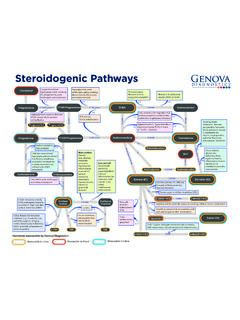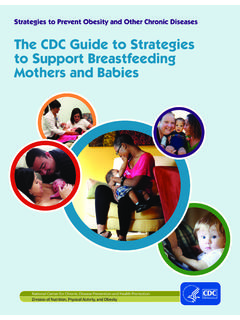Transcription of STOOL TESTING SUPPORT GUIDE - GDX
1 GUT HEALTHSTOOL TESTING SUPPORT GUIDE2 ContentsIntroduction ..3 Biomarker Comparision Charts ..4-5GI Effects Results Overview ..6 Functional Imbalance Scores ..7 Therapeutic SUPPORT Options ..7GI Effects Commensal Microbiome Analysis ..8 Commensal Abundance ..8 Commensal Dysbiosis Patterns ..9 Commensal Balance ..11 Digestion and Absorption ..12 Pancreatic Elastase 1 (PE-1) ..12 Products of Protein Breakdown ..14 Fecal Fats ..16 Chymotrypsin ..17 Meat Fibers & Vegetable Fibers ..17 Inflammation and Immunology ..18 Calprotectin ..18 Eosinophil Protein X (EPX) ..19 Fecal secretory IgA ..20 Fecal Lactoferrin ..21 Gastrointestinal (GI) Microbiome ..22 Metabolic Indicators ..23 Short Chain Fatty Acids (SCFAs) ..23 Beta-glucuronidase ..25 pH.
2 26 Secondary Bile Acids ..27 Commensal Bacteria ..28 Firmicutes/Bacteroidetes (F/B) Ratio ..31 Dysbiosis ..31 Commensal and Biomarker Clinical Associations ..32 Bacteriology and Bacteriology and Mycology Culture with Sensitivities ..34 Potassium Hydroxide (KOH) Prep for Yeast ..36 Pathogenic Bacteria EIA TESTING ..37 Parasitology ..38 Microscopic Ova & Parasites (O&P) ..38 Polymerase Chain Reaction (PCR) - Protozoa ..40 EIA Parasitology ..42 Macroscopic Examination for Worms ..42 Therapeutic Considerations for Parasitology ..42 Additional Tests ..43 Occult Blood ..43 Zonulin Family Peptide ..43 References ..45-52 fiffflffiff ffi ffl ffl ffl ffl fiffflfiffflffi ffifl fiff ffl fiffflfiffflffi ffifflflffi ff fflfiffflffi ffffi ffl ffi fffiffflflffi ffl fi ffi fiffflffi fl ffl fiffflffi ffl3 Introduction Advances in research, combined with clinical insight, confirm the essential role of the gut in determining overall health and wellness.
3 Genova s STOOL profiles offer a comprehensive evaluation of GI function paired with the broadest clinical utility available. It is important that clinicians possess these tools since they provide the most accurate and comprehensive assessment of gastrointestinal s line of STOOL TESTING provides immediate actionable clinical information for gastrointestinal health management. Utilizing both advanced technologies and premier biomarkers, the GI Effects STOOL Profiles and CDSA/CDSA Profiles offer valuable insight into digestive function, intestinal inflammation, as well as the gastrointestinal microbiota. Our tests are designed to identify potential root causes of symptoms. They assist clinicians by providing targeted therapeutics that improve symptoms and overall gut health.
4 In addition to providing a comprehensive set of GI functional biomarkers, our STOOL profiles incorporate the most sophisticated tools in evaluating the microbial community of the GI tract, known as the microbiota. Genova uses multiple methodologies to provide the most clinically accurate assessment of bacteria, yeast, and parasites currently available on the market. The GI Effects Profiles include quantitative assessment of commensal bacteria to determine healthy bacterial balance based on research and analysis of hundreds of thousands of patient results. This data-driven, evidence-based analysis establishes a firm foundation from which to base clinical decisions and , the GI Effects utilizes an innovative scoring system that synthesizes the biomarker findings and groups them into 5 key areas relating to GI function: maldigestion, inflammation, dysbiosis, metabolite imbalance, and infection.
5 This allows for clearer visualization of patterns among biomarkers. Protocol design and management of abnormal GI function through dietary, lifestyle, nutraceutical, and other relevant interventions are thus Effects Biomarkers Comparison Table 2200*2205*2207**Not Available in New YorkDigestion and AbsorptionPancreatic Elastase-1 Products of Protein Breakdown (Total) Fecal Fat (Total) Triglycerides Long Chain Fatty Acids Cholesterol Phospholipids Inflammation and ImmunologyCalprotectin Eosinophil Protein X (EPX) Fecal sIgA Metabolic SCFA (Total) (Acetate, n-Butyrate, Propionate) n-Butyrate Concentration n-Butyrate % Acetate % Propionate % Beta- glucuronidase Gastrointestinal MicrobiomeCommensal Bacteria (PCR)Bacteroidetes Phylum Bacteroides-Prevotella group Bacteroides vulgatus Barnesiella spp.
6 Odoribacter spp. Prevotella spp. Firmicutes Phylum Anaerotruncus colihominis Butyrivibrio crossotus Clostridium spp. Coprococcus eutactus Faecalibacterium prausnitzii Lactobacillus spp. Pseudoflavonifractor spp. Roseburia spp. Ruminococcus spp. Veillonella spp. Actinobacteria Phylum Bifidobacterium spp. Bifidobacterium longum Collinsella aerofaciens Proteobacteria Phylum Desulfovibrio piger Escherichia coli Oxalobacter formigenes Euryarchaeota Phylum Methanobrevibacter smithii Fusobacteria Phylum Fusobacterium spp. Verrucomicrobia Phylum Akkermansia muciniphila Firmicutes/Bacteroidetes (F/B Ratio) Bacteriology Mycology (Yeast/Fungi) ParasitologyMicroscopic Exam Results Parasitology PCR Tests Other BiomarkersFecal Occult Blood Color Consistency MIC Sensitivities, Yeast or Bacteria + Add-ons2203 Clostridium difficile EIA+++2204 Shiga toxin E.
7 Coli EIA+++2202 Campylobacter spp. EIA+++2206 Fecal Lactoferrin++2208 Helicobacter pylori EIA+++2331 Macro Exam for Worms++ 2336 Zonulin Family Peptide++2338 KOH Preparation for Yeast++ 5 CDSA Biomarkers Comparison Table CDSACDSA/PCDSA w/o P*Not Available in New YorkDigestion and AbsorptionPancreatic Elastase-1++ Products of Protein Breakdown (Total) Chymotrypsin ++Fecal Fats ++Meat Fibers Vegetable FIbers Gut ImmunologyFecal Lactoferrin Calprotectin++ Esosinophil Protein X++ Zonulin Family Peptide+Metabolic MarkersBeneficial SCFAs SCFA Distribution ++Beta-glucuronidase* pH n-Butyrate Lithocholic acid (LCA)++ Deoxycholic Acid (DCA)++ LCA/DCA Ratio++ Microbiology MarkersBacteriology Mycology Campylobacter EIA++++Shiga-like Toxin EIA++++Clostridium difficile EIA++++Helicobacter pylori EIA++++ParasitologyMicroscopic O&P EIA Macroscopic Exam for Worms+++6GI Effects Results Overview The GI Effects STOOL Profile report is organized to provide a quick overview and synthesis of results at the beginning of the report.
8 The results overview graphic reflects the status of the 3 key functions of gut health arranged in the DIG format: digestion, inflammation, and the gut microbiome. The gut microbiome section is further broken down into three components: infection, metabolite imbalance, and dysbiosis. These individual gut microbiome sections allow the practitioner to differentiate between interventions that are antimicrobial versus supportive of the microbiome. The color-coded circles reflect the need for SUPPORT in each area and help the practitioner prioritize therapeutic strategies. Green represents low need for SUPPORT , gray (optional), yellow (moderate), and red (high need). 7 The functional imbalance scores are generated using weighted algorithms that incorporate biomarkers belonging to each functional category.
9 The biomarkers that are represented in the algorithm are listed below the score in each functional column. A qualitative indicator of whether the biomarker is normal (green circle ) or abnormal (yellow or red arrow) is located adjacent to the biomarker name. The level of need for SUPPORT in a functional area is reflected both by the color and score in the circle. Green represents a low need for SUPPORT and corresponds with scores less than 2, grey represents an optional need for SUPPORT and corresponds with a score of 2 or 3, yellow indicates moderate need with scores of 4-6, and red indicates high need with scores of 7-10. Functional Imbalance ScoresTherapeutic SUPPORT OptionsTherapeutic SUPPORT options are listed at the bottom of each column. Therapeutic SUPPORT options are static on every report to serve as potential treatment ideas.
10 Clinician discretion is advised when selecting appropriate therapeutics for individual patients. More information on therapeutic SUPPORT options is discussed throughout this GUIDE as they relate to each GI Effects features a synthesis of the patient s microbiome data. In addition to listing amounts of the 24 commensal bacteria, Genova has developed unique algorithms that account for the levels of bacteria and translate the patient s microbiome data into clinically actionable information. The commensal microbiome analysis focuses in the areas of abundance, dysbiosis, and balance. Commensal AbundanceTotal Commensal AbundanceThe total commensal abundance is a sum-total of the reported commensal bacteria compared to a healthy cohort. Results are denoted with a circle and reported as a percent variance from healthy cohort levels.













